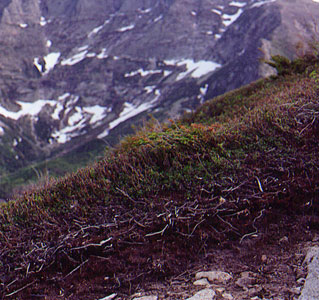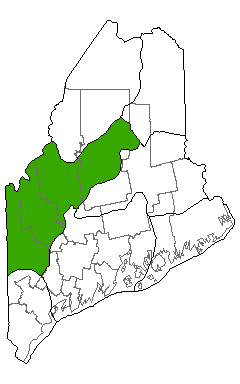DACF Home → Bureaus & Programs → Maine Natural Areas Program → Communities, Plants, and Animals → Natural Community Fact Sheets → Alpine Snowbank
Printer Friendly Fact Sheet - 1.2 MB pdf (Get a free copy of Adobe Acrobat Reader)
Alpine Snowbank
Scientific Name: Bilberry - Mountain Heath Alpine Snowbank; State Rank: S1

- Community Description
- Soil and Site Characteristics
- Diagnostics
- Similar Types
- Conservation, Wildlife and Management Considerations
- Distribution
- Characteristic Plants
- Associated Rare Plants
- Associated Rare Animals
- Examples on Conservation Lands You Can Visit
Community Description: Dwarfed alpine shrubs form low mats, with herbs interspersed. Alpine bilberry and/or dwarf bilberry are dominant, but moss-plant and mountain-heath can form extensive patches among the bilberry. The relatively protected habitat amid otherwise exposed alpine vegetation allows some lower elevation species to exist, including Canada mayflower, bunchberry, mountain wood fern, bluebead lily, large-leaved goldenrod, and common hairgrass. Bryoids may be locally abundant, and include hair-cap mosses and red-stemmed moss. Back to top.
Soil and Site Characteristics: Sites occupy protected upper mountain slopes above treeline, such as upper cirque walls. Snow lingers here after it has melted from the rest of the alpine zone. Back to top.
Diagnostics: Sites occur in protected habitats above treeline; bilberries are dominant; tundra dwarf birch, mountain-heath, and/or moss-plant are characteristic. Back to top.
Similar Types: Rocky Summit Heath occurs at lower elevation and lacks the strictly alpine species typical of this type. Heath Alpine Ridge is similar (and often adjacent) but lacks the characteristic snowbank species (moss-plant and mountain-heath), as well as those typical of lower elevations. Windswept Alpine Ridge can also be adjacent, but is dominated by diapensia. Alpine Cliff vegetation has a higher proportion of herbaceous species and occurs on seeps, with a well developed bryophyte layer. Back to top.
Conservation, Wildlife and Management Considerations: The major documented occurrence of this type in Maine is on Katahdin. Hiker impacts to this type appear minimal, because most of its area is away from trails. Monitoring of impacts where alpine snowbank vegetation occurs near trails could help determine management needs.
Mt. Katahdin is the only known nesting area in the state for the rare American pipit, which utilizes a variety of natural community types above treeline. Back to top.
Distribution: Restricted to Maine's highest mountains (New England- Adirondack Province), extending west to New Hampshire and along the Appalachians. Landscape Pattern: Small Patch. Back to top.


Characteristic Plants: These plants are frequently found in this community type. Those with an asterisk are often diagnostic of this community.
- Dwarf Shrub
- Alpine bilberry*
- Dwarf bilberry*
- Moss-plant
- Mountain cranberry
- Mountain-heath
- Pale laurel
- Herb
- Bunchberry
- Canada mayflower
- Common hairgrass*
- Stiff clubmoss
- Bryoid
- Awned hair-cap moss
- Juniper hair-cap moss
- Alpine azalea
- Alpine bearberry
- Bearberry willow
- Bigelow's sedge
- Boreal bentgrass
- Lapland rosebay
- Mountain-heath
- Northern comandra
- American pipit
Examples on Conservation Lands You Can Visit
| Example | County |
|---|---|
| Mt. Katahdin, Baxter State Park | Piscataquis Co. |